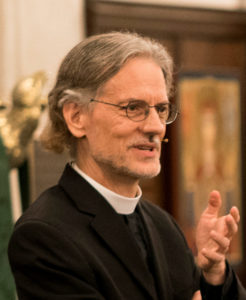Human from Womb to Tomb
March 25 is the feast of the Annunciation, the annual celebration of the angel’s announcement to the Virgin Mary that she would conceive and give birth to Jesus. Since March 25 falls in Holy Week this year, its celebration has been postponed to the second week of Easter. Nonetheless, it is instructive to hold the coincidence this year in mind, to ponder Jesus being conceived in the same week as he died.
When Mary consented to the word of the angel, she conceived the Word in her womb. Jesus began his life, as all of us do, as a so-called fertilized egg. Of course this description is misleading because, once fertilized, the egg is no longer an egg but a zygote—the tiniest human being—beginning an amazing (and still often mysterious) process of cellular division and organization that cascades through the first hours and days and weeks of human life. In Mary’s case, the fertilization was a miracle done directly by God without male participation. She listened; she assented to what was asked of her; Jesus was conceived. In some paintings, this moment of divine conception is depicted by a dove, representing the Holy Ghost, flying towards Mary’s ear.
So, although miraculously initiated, Jesus’ human life was like ours, beginning so small it could not have been seen by an unaided human eye. And it ended, too, as ours will: with a heart that stops beating and a brain that stops functioning, rendering the whole organism lifeless. After Jesus died, his body was removed to a tomb, where it was protected from desecration. This is how most but not all humans are treated after death. Some bodies are lost or abandoned, violated, eaten by vultures or suffer other such cruelty; but most are buried or cremated. Jesus was unique, however, in that his body did not remain lifeless. Rather than returning to dust, it was raised from the tomb, an out-of-time foretaste of what is to be universal at the end of time—a general resurrection.
Human from womb to tomb, Jesus conferred special dignity on the ordinary span of human life. And when March 25, the celebration of the inception of his life, coincides with Holy Week and the journey to his death, one senses the two ends of his life touching each other. The manger and the pieta are layered and become one image: the mother cradling her baby being the mother whose lap and arms underlie the body taken down from the cross. Clergy have the privilege (there is no more appropriate word) of entering into such sacred moments. A baby is born, and we offer prayers in the hospital room or at home. A child dies, and we are again invited in. There is the mother, and there the body of her son; tears are in all our eyes, including mine, but one knows that nothing compares with the feeling in that mother’s heart: This boy of mine, whose body I now touch and weep beside, was once in my womb and once nursed in my arms.
At the beginning and at the end—there we know we touch the sacred, and we feel it particularly when we perceive the end and the beginning together. Spouses can feel something similar. I never knew my wife as a baby or even as a girl—we first met at college. But we knew each other for decades. Then came that morning when I entered the hospital room and shortly learned that she had just died, that the rise and fall of her chest was the respirator’s work only. The hand one touches then, and the hand one first held as an awkward boy, are somehow the same hand. It is simultaneously 1974 and 2012. It is sacred now as it was sacred then. It is human.
As the saying goes, people die every day. Babies are born all the time. And life is hard in a million ways. It is hard to remember the sacred when it is so ordinary. An additional difficulty for us, in the year 2024, comes because we increasingly engage with images and pixels rather than flesh and blood and other physical stuff. But the point is that ordinary physical stuff is sacred, part of every human being’s unique story—their personal beginning and personal end—a good story that hangs together, one in which somehow the end fits the beginning. I am moved particularly that Mary was there through the whole story of Jesus, just as I am moved to tears with a mother (or father) who comes to the end of her son’s (or daughter’s) life. Our condition of being human from womb to tomb is neither a good thing nor a bad thing. It is simply a true thing, something that Jesus himself went through, something dignified, something sacred.










